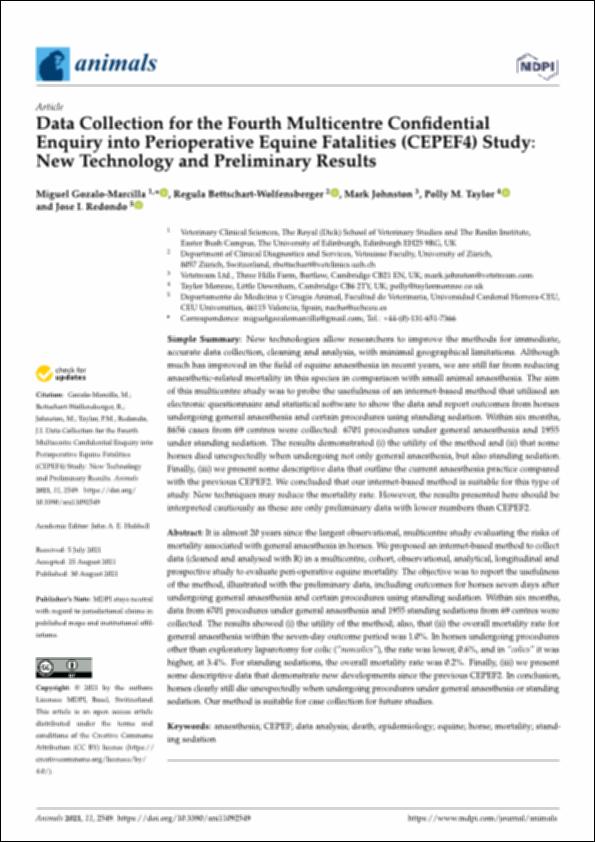Please use this identifier to cite or link to this item:
http://hdl.handle.net/10637/13396Data collection for the fourth multicentre Confidential Enquiry into Perioperative Equine Fatalities (CEPEF4) study : new technology and preliminary results
| Title: | Data collection for the fourth multicentre Confidential Enquiry into Perioperative Equine Fatalities (CEPEF4) study : new technology and preliminary results |
| Authors : | Gozalo Marcilla, Miguel Bettschart-Wolfensberger, Regula Johnston, Mark Taylor, Polly Redondo García, José Ignacio |
| Keywords: | Horses - Anesthesia.; Análisis de datos.; Mortalidad.; Veterinary anesthesia.; Caballos - Anestesia.; Data analysis.; Anestesia veterinaria.; Mortality. |
| Publisher: | MDPI |
| Citation: | Gozalo-Marcilla, M., Bettschart-Wolfensberger, R., Johnston, M., Taylor, P. M., & Redondo, J. I. (2021). Data collection for the fourth multicentre Confidential Enquiry into Perioperative Equine Fatalities (CEPEF4) study: new technology and preliminary results. Animals, vol. 11, i. 9 (30 aug.), art. 2549. DOI: https://doi.org/10.3390/ani11092549 |
| Abstract: | It is almost 20 years since the largest observational, multicentre study evaluating the risks of mortality associatedwith general anaesthesia in horses. We proposed an internet-basedmethod to collect data (cleaned and analysed with R) in a multicentre, cohort, observational, analytical, longitudinal and prospective study to evaluate peri-operative equine mortality. The objective was to report the usefulness of the method, illustrated with the preliminary data, including outcomes for horses seven days after undergoing general anaesthesia and certain procedures using standing sedation. Within six months, data from 6701 procedures under general anaesthesia and 1955 standing sedations from 69 centres were collected. The results showed (i) the utility of the method; also, that (ii) the overall mortality rate for general anaesthesia within the seven-day outcome period was 1.0%. In horses undergoing procedures other than exploratory laparotomy for colic (“noncolics”), the rate was lower, 0.6%, and in “colics” it was higher, at 3.4%. For standing sedations, the overall mortality rate was 0.2%. Finally, (iii) we present some descriptive data that demonstrate new developments since the previous CEPEF2. In conclusion, horses clearly still die unexpectedly when undergoing procedures under general anaesthesia or standing sedation. Our method is suitable for case collection for future studies. |
| Description: | Este artículo se encuentra disponible en la siguiente URL: https://www.mdpi.com/2076-2615/11/9/2549 Este artículo de investigación pertenece al número especial que lleva por título "Anesthesia and Analgesia in Equids". |
| URI: | http://hdl.handle.net/10637/13396 |
| Rights : | http://creativecommons.org/licenses/by/4.0/deed.es |
| ISSN: | 2076-2615 (Electrónico) |
| Issue Date: | 30-Aug-2021 |
| Center : | Universidad Cardenal Herrera-CEU |
| Appears in Collections: | Dpto. Medicina y Cirugía Animal |
Items in DSpace are protected by copyright, with all rights reserved, unless otherwise indicated.


